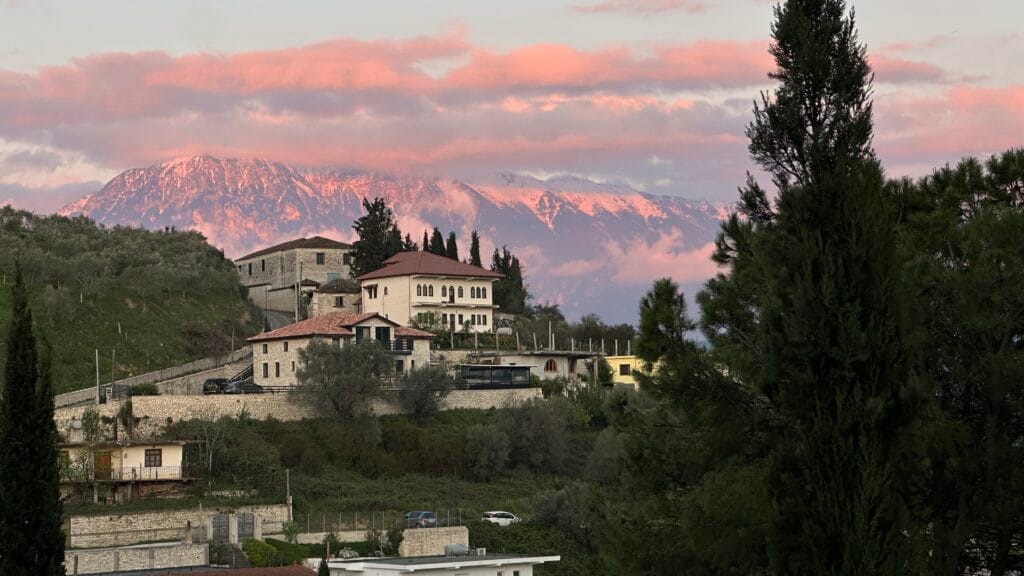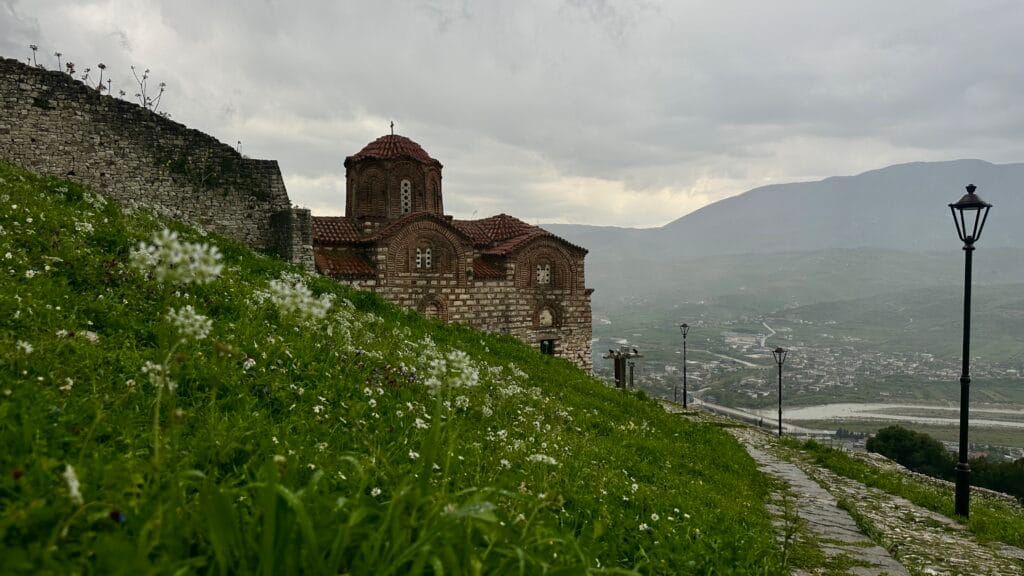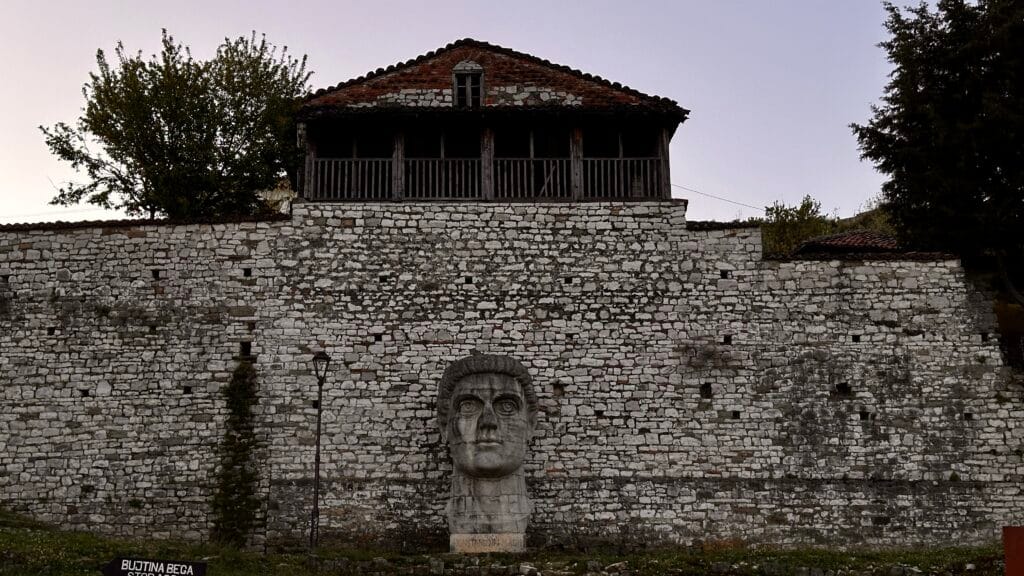Your First 10 Rides Discounted 🚕
Use "WEB" as your referral code, for a free 50 Toko bonus.

Use "WEB" as your referral code, for a free 50 Toko bonus.
The ancient city of Berat stands as a living monument to over 2,400 years of continuous human habitation. Often called the “City of a Thousand Windows” for its distinctive Ottoman-era houses with their countless windows cascading down the hillside, Berat offers visitors a mesmerizing journey through time. (For what it’s worth, that’s not 100% an accurate translation of Qyteti i Një-Mbi-Një Dritareve, it’s more accurate to say ‘City of One Above Another Window.’)
This UNESCO World Heritage Site showcases a remarkable fusion of Eastern and Western cultures, religious harmony, and architectural brilliance that has withstood the test of time.
Berat’s white Ottoman houses with their iconic windows create a striking visual panorama, while its ancient castle keeps watch from above. As you wander through its historic quarters, you’ll discover Byzantine churches adorned with priceless frescoes, Ottoman mosques with elegant minarets, and a river that gently divides the city’s historic neighborhoods.
This comprehensive guide explores everything you need to know about Berat – from its fascinating history and cultural significance to practical travel information for making the most of your visit to this Albanian gem.

Berat’s origins trace back to antiquity when the area was inhabited by the Illyrians, an ancient Indo-European people who established settlements in the region. The city’s formal beginnings are often attributed to the 3rd or 4th centuries BC when a Macedonian city named Antipatreia was established, named after the Macedonian general Antipater. This early foundation established Berat as a strategic location, situated along important trade routes that connected coastal areas with inland regions.
Following its Macedonian establishment, Berat became part of the Roman Empire and subsequently fell under Byzantine control, with each civilization leaving distinctive marks on the city’s development. During the Byzantine era, the city was known as Pulcheriopolis, meaning “Beautiful Town” and saw the introduction of Christianity leading to the construction of numerous churches that would become architectural treasures. This period saw the strengthening of the city’s defenses under Roman Emperor Theodosius II in the 5th century, with further reinforcements during the 6th century under Emperor Justinian I.
In 1417, Berat fell under Ottoman rule, beginning a period that would profoundly shape its architectural character and cultural identity for centuries to come. The Ottoman era brought prosperity and architectural splendor, with the development of the distinctive Ottoman houses characterized by their white facades and wooden balconies that now define the city’s famous skyline. According to Wikipedia, the city remained under Ottoman control until 1912, when Albania gained independence. During the communist period (1944-1991), Berat was declared a “museum city” in 1961, a designation that helped preserve its unique architectural heritage.

Berat, together with Gjirokastra, was inscribed on the UNESCO World Heritage List in 2008, recognizing its exceptional universal value. This prestigious designation highlights the city’s profound cultural importance and the need to protect its unique heritage for future generations. The recognition brings international attention to Berat, leading to increased tourism and opportunities for conservation efforts. According to UNESCO, Berat represents “a rare example of an architectural character typical of the Ottoman period” and stands as a testament to “the coexistence of various religious and cultural communities through the centuries.”
The UNESCO World Heritage status ensures the protection of Berat’s historic center, encompassing the iconic castle (Kalaja) and the old town with its distinctive Ottoman-era architecture. This protection extends to the vernacular buildings, the numerous Byzantine churches within the castle and the Gorica quarter, and the Ottoman mosques primarily located in the Mangalem quarter. According to UNESCO documentation, the goal is to maintain “the overall integrity and authenticity of the towns, preserving their historical fabric and architectural character.”
Berat Castle, locally known as Kalaja, stands majestically atop a hill overlooking the city and the Osum River. Its origins trace back to the 4th century BCE, initially fortified by the Illyrian Parthini tribe, making it a site with over 2,400 years of continuous human habitation. According to Albania Visit, it’s one of the oldest continuously inhabited fortresses globally. Throughout its long history, Berat Castle has witnessed numerous periods of construction, destruction, and rebuilding, reflecting the ebb and flow of power in the region.
One of the most fascinating things about staying within the castle was watching some of the daily life of those who live within it. When we were on early morning walks, we’d run into people in their daily lives, heading to work, or walking a dog. -Personal Traveller Anecdote
The castle boasts impressive architectural features that reflect its long and varied history. According to historical records, the imposing surrounding walls stretch over 1,000 meters in length, reaching up to 10 meters in height and 5 meters in thickness in some sections, originally featuring 24 watchtowers. The architecture within the castle precinct is a fascinating blend of Byzantine and Ottoman styles, a tangible representation of the different periods during which the castle was expanded and modified.
The interior of Berat Castle is a treasure trove of historical and cultural landmarks, most notably its numerous Byzantine-era Albanian Orthodox churches, many dating back to the 13th century. These churches are adorned with exquisite frescoes and iconostasis created by renowned Albanian icon painters such as Onufri, whose works are displayed in the Onufri Museum located within the Cathedral of St. Mary.
What makes Berat Castle truly unique is that it remains a living fortress, with a community still residing within its walls, inhabiting homes dating from the 13th to 19th centuries. As Albania Visit notes, this offers visitors an unparalleled opportunity to experience history in a living context rather than just viewing abandoned ruins.

The Mangalem Quarter, located on the right bank of the Osum River at the base of the castle hill, is traditionally the Muslim quarter of Berat. This neighborhood is renowned for its dense concentration of multi-story wooden houses with distinctive white facades and numerous windows, which cascade down the steep hillside in a tiered formation. This unique architectural style, where houses appear to be stacked one above the other, has earned Berat its famous nickname, “The City of One Above One Windows”.
Several important historical and religious sites are located in Mangalem, including the King Mosque (Xhamia e Mbretit), built in 1492 by the Ottoman Sultan Bayezid II, which is one of the oldest and most significant mosques in Albania. The quarter also houses the Ethnographic Museum, offering insights into the region’s cultural heritage within a beautiful 18th-century Ottoman house.
Across the Osum River from Mangalem lies the Gorica quarter, traditionally inhabited by the Orthodox Christian population of Berat. According to Albania.al, Gorica is connected to Mangalem by the iconic Gorica Bridge, a grand Ottoman-era stone bridge with seven arches. Compared to the bustling Mangalem, Gorica offers a quieter, more residential atmosphere, characterized by its stone houses and winding alleys.
While Mangalem is notable for its mosques, Gorica is distinguished by its churches, reflecting its historical Christian population. Among the notable religious sites in Gorica are the 19th-century Church of Saint Spiridon and the Church of Saint Thomas, a smaller structure offering picturesque views of the opposite bank of the river.

Berat boasts a significant number of Byzantine-era Albanian Orthodox churches, particularly concentrated within the walls of Berat Castle and in the Gorica quarter. Many of these churches date back to the 13th and 14th centuries, a period of considerable Byzantine influence in the region. According to Feel Albania, they typically exhibit classic Byzantine architectural features, including a cross-shaped plan, domes, and intricate stone carvings.
Among the most significant Orthodox churches in Berat are:

During the long period of Ottoman rule, which began in 1417, several mosques were constructed in Berat, primarily in the Mangalem quarter and within the castle walls. Notable examples include:
The Osum River flows through the heart of Berat, gracefully dividing the historical quarters of Mangalem and Gorica. As Wikipedia notes, the Osum stretches for 161 km across southern Albania. The iconic Gorica Bridge, with its distinctive arches, spans the Osum, connecting the two historic old town areas and serving as a vital artery for the city.
According to local folklore, a legend attributes the river’s origin to the tears of a heartbroken fairy named Osum, who grieved the loss of two brothers who fought for her love. Today, the Osum River is not only a defining geographical feature but also a hub for recreational activities such as kayaking, attracting adventure enthusiasts to explore its waters.
Dominating the eastern skyline of Berat is the majestic Tomorr Mountain, reaching an elevation of 2,416 meters. This imposing peak holds immense cultural and religious significance for Albanians, often referred to as a holy mountain and associated with various myths and legends. According to World Wide Walkies, Tomorr is linked to the figures of Baba Tomor and Zojz in Albanian folk beliefs and is a site of annual pilgrimages.
Local legend vividly recounts the tale of two brothers, Tomorr and Shpirag, who engaged in a fierce battle for the affections of the fairy Osum. In this tragic story, Tomorr is said to have transformed into the mountain that now bears his name, forever separated from his brother by the river created from Osum’s tears.
A cornerstone of Berat’s cultural tradition is the strong emphasis on religious tolerance and the peaceful coexistence of different faiths. This value has been passed down through generations and is evident in the harmonious relationship between the Muslim and Christian communities.
A popular local custom is the “Xhiro,” an evening stroll, typically taken before and at sunset, along the city’s promenades, such as Bulevardi Republika and the promenade along the Osum River. According to Global Grit + Glam, this tradition provides an opportunity for people of all ages to socialize and enjoy the city’s ambiance.
Berat hosts a variety of festivals throughout the year, reflecting its cultural vibrancy and community spirit. These include the annual Friendship Party, a popular event held in August featuring guest singers, local food, and beer. According to Berat.al, other notable festivals include the Cherry Festival in Mbreshtan, celebrating the local cherry harvest, and the Olive Festival in Bilçë village, promoting local olive products and traditional foods.
Reaching Berat can be straightforward, with several options available depending on your starting point and preference for convenience. However, these times and locations can change often.
Bus Travel:
Public buses connect Berat with major Albanian cities like Tirana, Vlorë, and Sarandë. While generally affordable, finding consistently updated timetables and precise schedules for intercity buses can sometimes be challenging for travelers.
Patoko Taxi Service:
For a more direct and convenient journey, Patoko offers reliable taxi services to Berat. Enjoy a comfortable ride with a flat rate of 12,000 lek (approximately €120), eliminating the uncertainty of bus schedules and providing door-to-door service. This is an excellent option for travelers seeking comfort, speed, and predictability.
Airport Transfers:
Patoko also facilitates seamless travel connections with airport transfers from Berat directly to Tirana International Airport (TIA). This service is available at the same flat rate of 12,000 lek (€120), ensuring a stress-free journey to catch your flight.
Timing your visit to Berat can make all the difference in your experience. According to Where and When, the best months to explore this charming city are April through October. During this period, the weather is pleasant, with warm temperatures and plenty of sunshine. May and June are particularly ideal, offering daytime temperatures between 77.5°F (25.3°C) and 86.7°F (30.4°C).
If you prefer warmer weather, July and August are the hottest months. However, these months can also be busier with tourists. For a quieter experience, consider visiting in late spring or early autumn. Avoid January and February if you dislike rain, as these are the wettest months in Berat.
“We really enjoyed the crisp air in Early April 2025 in Berat, which coincided with the Berat Marathon. There also wasn’t much tourism during this time of year, and ensured we could find stays with ease. If you’re looking for an off-season win, I’d highly recommend a spring visit to the castle of Berat.” -Personal Traveller Anecdote
According to the 2023 census, the municipality of Berat has a total population of 62,232 residents spread across an area of 421.6 km², with a population density of 150 people per square kilometer. The municipal unit of Berat (the city proper) contains 40,665 inhabitants with a remarkably high population density of 3,600 people per square kilometer, reflecting the compact nature of the historic urban core.
Berat’s population has undergone significant fluctuations over the past several decades, as shown in this historical population data:
| Year | Population | Change |
|---|---|---|
| 1950 | 11,648 | — |
| 1960 | 18,685 | +60.4% |
| 1969 | 24,700 | +32.2% |
| 1979 | 33,400 | +35.2% |
| 1989 | 46,210 | +38.4% |
| 2001 | 44,040 | -4.7% |
| 2011 | 36,496 | -17.1% |
| 2023 | 40,665 | +11.4% |
The data shows a substantial period of population growth from the mid-20th century until 1989, followed by a decline in the post-communist era, likely due to economic factors and emigration. However, the recent census data from 2023 indicates a renewed increase in the population, suggesting a potential stabilization or new phase of growth.
Berat stands as an extraordinary testament to human creativity, cultural resilience, and historical continuity in the face of changing political powers and social circumstances. Its exceptional architectural heritage, spanning from ancient fortifications to Ottoman houses with their iconic windows, creates a visual narrative of urban evolution across more than two millennia.
The city’s unique position as a place of religious coexistence and cultural exchange has produced a rich tapestry of traditions that continue to inform contemporary life. While facing challenges common to historic urban centers—balancing preservation with development, managing tourism impacts, and addressing demographic changes—Berat demonstrates remarkable adaptability.
As Albania continues to integrate more fully with Europe and welcome international visitors, Berat’s significance extends beyond national borders to represent a shared cultural heritage that illuminates the complex historical interactions that have shaped Balkan identity. The “City of a Thousand Windows” not only offers views of stunning landscapes but provides windows into a fascinating past that continues to resonate in the present.
Walking is the best option! The city is compact, and its cobblestone streets are perfect for exploring on foot. It’s a bit hilly, but there are also a fair amount of bikers around the city. Additionally, car rentals can take on some of the hilly streets.
Absolutely! Try Tave Kosi (baked lamb with yogurt) and Byrek (savory pastry). Pair them with local wine and local olives to taste the local expertise.
Berat had some of the best squash/pumpkin bread (Byrek) that I’ve had in Albania! -Personal Traveller Anecdote
Yes, you could! The journey takes about two hours via Taxi. Start early to make the most of your day. However, to really appreciate the city, staying in the historic castle for at least a night makes you feel the past.